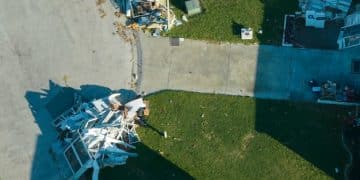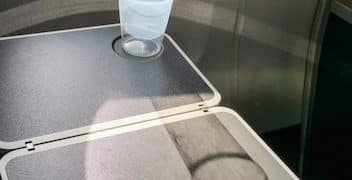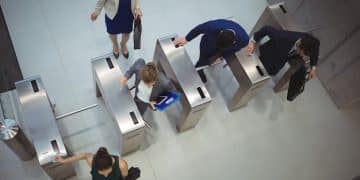FAA Warns of Counterfeit Aircraft Parts: Identification and Prevention

The FAA has issued a warning regarding the increasing prevalence of counterfeit aircraft parts, emphasizing the importance of identification and avoidance to ensure aviation safety and regulatory compliance.
The FAA issues warning about counterfeit aircraft parts: how to identify and avoid them to ensure safety in the skies. These parts pose a significant risk to aircraft integrity and passenger safety, so it’s essential for aircraft owners, operators, and maintenance personnel to be vigilant.
Understanding the FAA’s Counterfeit Parts Warning
The FAA’s warning highlights a growing concern: the proliferation of counterfeit aircraft parts. These parts, often cheaper imitations of original manufacturer components, can have devastating consequences if installed on an aircraft.
These unapproved parts don’t meet the rigorous testing and quality control standards of genuine parts and may fail during flight, causing accidents and endangering lives.
What Makes Parts Counterfeit?
Counterfeit aircraft parts can range from bolts and fasteners to engine components and electronics. These parts are misrepresented as being produced by an approved manufacturer when they are not.
They may be made from substandard materials, manufactured with incorrect dimensions, or lack the necessary certifications.
- False Identification: Parts are labeled with fake certification documents or manufacturer names.
- Substandard Materials: Use of lower-quality metals or plastics than specified by the original design.
- Poor Manufacturing: Components made with incorrect tolerances or lacking necessary heat treatments.
The warning issued by the FAA serves as a wake-up call for the aviation industry to be more vigilant.
The Risks Posed by Counterfeit Parts
The use of counterfeit aircraft parts is a serious safety issue that can lead to catastrophic consequences. Unlike genuine parts, counterfeit components often fail to meet the required performance standards, resulting in potentially deadly scenarios.
The failure of a critical component during flight can compromise the aircraft’s structural integrity and control systems, increasing the chances of an accident.

The risks extend beyond immediate safety concerns and can have long-term financial implications for aircraft owners and operators.
- Component Malfunction: Premature failure of parts leading to in-flight emergencies.
- Increased Maintenance: More frequent repairs and replacements due to substandard components.
- Liability Issues: Legal and financial repercussions in the event of an accident caused by fake parts.
The FAA’s warning is a reminder of the importance of verifying and validating the authenticity of aircraft parts to ensure the safety and reliability of aircraft operations.
It’s essential to protect against the risks posed by counterfeit components and maintain the highest standards of safety and quality in aviation.
How to Identify Counterfeit Aircraft Parts
Spotting counterfeit aircraft parts requires attention to detail and a thorough understanding of legitimate components. It is paramount to inspect each part for discrepancies.
Often, subtle differences in markings, materials, or packaging can indicate that a part is not genuine.
Visual Inspection
Carefully examine the part for any irregularities, such as misspellings, inconsistent fonts, or incorrect logos. Check for signs of tampering or damage.
Also, compare the part to the original manufacturer’s specifications to ensure it matches in terms of dimensions, shape, and finish.
Documentation Verification
Request and review the part’s documentation, including its certification papers and traceability records. Verify that the documentation is authentic and corresponds to the part’s manufacturer and specifications.
If there are any discrepancies or inconsistencies, such as missing or altered information, it is prudent to investigate them further.
- Check Certifications: Verify that the part has the required certifications from approved aviation authorities.
- Trace the Supply Chain: Ensure that the part comes from a reputable and authorized distributor.
- Cross-Reference Information: Compare the part number, serial number, and other identifying information against the manufacturer’s records.
By taking the time to perform a thorough inspection and verification process, aircraft owners, operators, and maintenance personnel can ensure the reliability and safety of their aircraft.
Preventive Measures to Avoid Counterfeit Parts
In addition to identifying counterfeit parts, taking proactive steps can go a long way in preventing them from entering the supply chain. These precautions can help reduce the risk of encountering fake components.
Purchasing parts only from authorized distributors and suppliers is one of the most effective ways to ensure authenticity. These sources are vetted and authorized by the original equipment manufacturers (OEMs) to sell genuine parts.

Implementing a robust quality control system that includes regular audits and inspections is also key to catching counterfeit parts. This should be done by qualified personnel who are trained to spot discrepancies.
- Buy from Authorized Distributors: Purchase parts only from suppliers authorized by the manufacturer.
- Implement Quality Control: Conduct regular audits and inspections to check for irregularities.
- Educate Employees: Train maintenance personnel on how to identify and report suspected counterfeit parts.
The FAA also recommends reporting any suspected counterfeit parts or fraudulent activity to the authorities. This can help prevent fake parts from circulating in the market and protect the integrity of the aviation industry.
The FAA’s Role in Combating Counterfeit Parts
The FAA plays a vital role in combating the proliferation of counterfeit aircraft parts by establishing regulations, conducting inspections, and taking enforcement actions against those who violate the rules. It actively works to ensure the safety and reliability of the aviation system.
One of the FAA’s key responsibilities is to develop and enforce regulations that require aircraft owners, operators, and maintenance personnel to use only approved parts. This includes conducting inspections of aircraft maintenance facilities and distributors to ensure compliance with these regulations.
Regulations and Guidelines
The FAA has established specific guidelines and regulations to ensure that all aircraft parts meet the necessary safety and performance standards.
These guidelines cover various aspects of part manufacturing, testing, and certification.
Enforcement Actions
The FAA takes enforcement actions against individuals and organizations that violate its regulations regarding unapproved parts.
These actions can include fines, penalties, and even revocation of certifications and licenses.
- Regulatory Oversight: Enforcing regulations that require the use of approved parts.
- Inspection Programs: Conducting regular inspections of maintenance facilities and distributors.
- Collaboration: Working with other agencies and organizations to combat counterfeit parts.
The FAA is constantly working to improve its efforts to combat counterfeit parts and protect the safety of the aviation system.
Staying Informed: Resources and Updates
Keeping up-to-date with the latest warnings, advisories, and best practices related to counterfeit aircraft parts is essential for everyone involved in aviation. Awareness strengthens the collective defense against substandard products.
The FAA provides many resources and updates designed to inform and educate the aviation community. These resources include safety alerts, advisory circulars, and webinars.
Staying informed also involves participating in industry associations and attending conferences and workshops that address the issue of counterfeit parts.
- FAA Website: Regularly check the FAA website for safety alerts, advisory circulars, and other important updates.
- Industry Associations: Join aviation industry associations to stay informed about best practices and emerging threats.
- Training Programs: Participate in training programs and workshops on how to identify and avoid counterfeit parts.
Staying informed and vigilant are key elements in the fight against counterfeit parts and in maintaining the safety and reliability of aviation operations.
By taking the time to educate themselves and others, individuals can make a real difference in preventing fake components from entering the supply chain.
| Key Point | Brief Description |
|---|---|
| ⚠️ FAA Warning | Alert on the proliferation of fake aircraft parts. |
| 🔍 Identification | Inspect parts carefully for irregularities. |
| 🛡️ Prevention | Buy from authorized distributors only. |
| 📚 Stay Informed | Keep updated with FAA warnings and industry news. |
Frequently Asked Questions
▼
Counterfeit aircraft parts are components misrepresented as being manufactured by an approved entity when they are not. They don’t meet safety and quality standards.
▼
The FAA is warning about the increasing prevalence of fake aircraft parts which pose significant safety risks due to their substandard quality and potential for failure during flight.
▼
Inspect for visual irregularities, verify documentation, and purchase only from authorized distributors to help identify potentially unapproved aircraft parts and mitigate risks.
▼
If you suspect a part is counterfeit, immediately report it to the FAA and remove the part from service. Do not use it in any aircraft maintenance activities.
▼
You can find more information about FAA-approved parts on the FAA website, through advisory circulars, and by contacting authorized aircraft parts distributors.
Conclusion
The FAA’s warning about counterfeit aircraft parts underscores the critical importance of vigilance and adherence to safety protocols within the aviation industry. By staying informed, implementing robust quality control measures, and prioritizing the use of approved parts, aircraft owners, operators, and maintenance personnel can help to mitigate the risks posed by counterfeit components and ensure the safety and reliability of aircraft operations.





